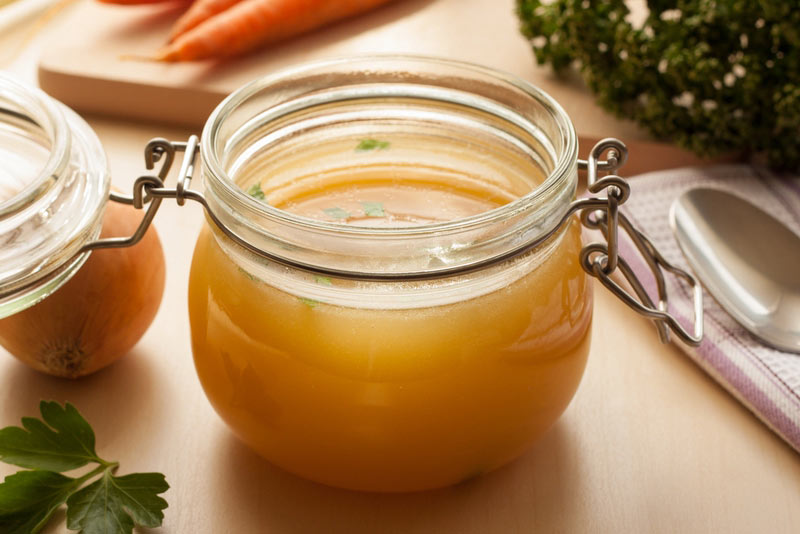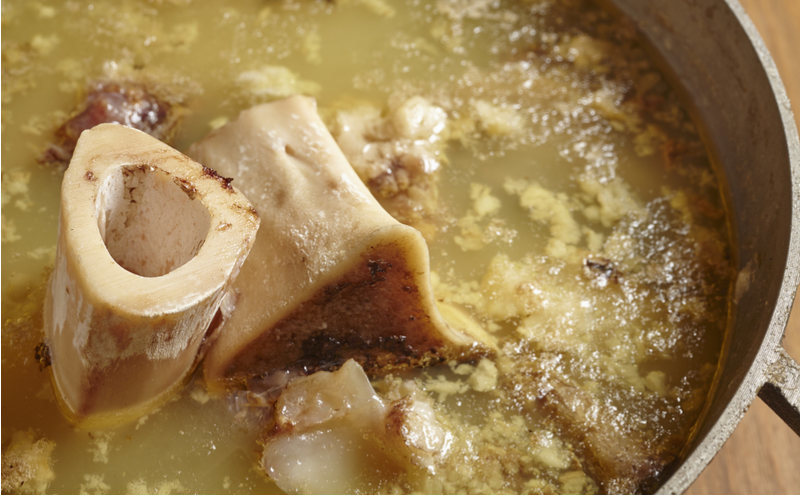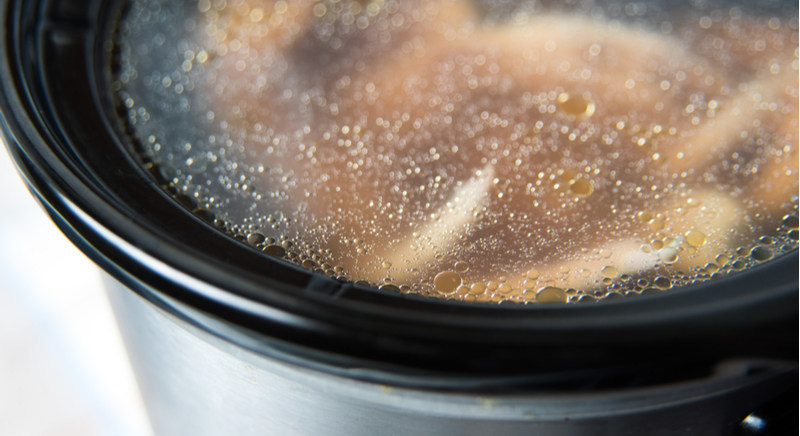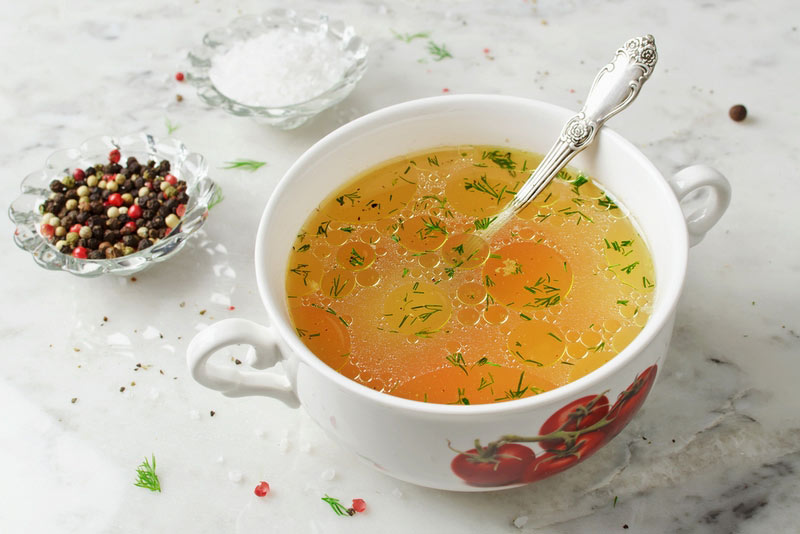Stock vs Broth. What’s the Difference? (Plus: 6 Tips to The Perfect Bone Broth)

Bone broth promotes gut health, strong bones, smooth skin, healthy hair and nails, and energy – maybe that’s why it’s also known as “liquid gold.”
You could buy a carton of bone broth online, at your local health store, and many grocery stores. But bone broth is best made at home, letting you control what goes into it and making use of your leftover bones and animal products.
Before we get into making bone broth at home, let’s break down some key information about broth and stock in general, and why you need to start incorporating health-supportive bone broth into your diet.
Stock vs Broth

The term broth is pretty much a catch-all for any flavorful liquid. When you purchase stocks or broths from the grocery store, you will often see the same ingredients listed for both.
Broths and stocks both come salted and unsalted. They can be labeled fish, chicken, or beef; you can find low sodium varieties of all of the above. Is the difference between the two simmered liquids just in the eye of the beholder?
Yes. There are key differences between broth and stock, according to their culinary definitions.
Stock
Making stock involves simmering animal bones with or without meat and vegetables. It’s often simmered with aromatics for four to six hours. Usually stock is used to replace water for soups, stews, braises, sauces or for poaching.
Stocks become gelatinous when chilled due to the collagen that is extracted from the animal bones during the simmering process.
Broth
Broth is made from simmering vegetables with animal bones along with some meat to create a flavorful liquid. This may also include fish, fish bones, and legumes.
Broth requires less simmering time than a stock, around 45 minutes to two hours. It can be served on its own and stays fluid when chilled.
What Really Sets Broth and Stock Apart?
These are the technical culinary definitions of broth and stock, but if you ask a chef, they’d probably tell you it’s not about the way the liquids are prepared, but how they’re used.
In most kitchens, a stock is an unseasoned, flavorful liquid used as a building block in reductions, sauces, braises, soups, stews or as poaching liquid. It may or may not be gelatinous when chilled, depending on simmer time and if bones were used in the preparation.
Broth is also a seasoned, flavorful liquid, but it’s served on its own or as the main component of a dish. It too may or may not be gelatinous when chilled.
While traditional broths and stocks always involve bones, meat or fish, there are also dashi broths (made from kombu and bonito flakes) as well as mushroom stocks and broths, where animal products make no appearance.
So, What is Bone Broth?

The medicinal and beautifying effects of simmered bones, skin, and cartilage from clean and grass-fed animals helps bone broth get its reputation as “liquid gold.”
The main distinction with bone broth is the emphasis on collagen extraction. The collagen content in bone broth produces an unmistakable jiggle once the simmered liquid is gelatinous and chilled.
Soaking your bones in apple cider vinegar, or adding apple cider vinegar to the broth while it simmers, may help extract the collagen. You can also expect to simmer your bone broth for 12 to 24 hours to extract the most nutrition.
Bone broth is, of course, comforting and nourishing as a hot liquid, but it’s unique in its combination of healing amino acids glutamine, glycine and proline. This liquid gold is said to relieve joint pain, improve digestion and potentially promote more restful sleep, more energy, and clearer thinking. (1, 2, 3, 4)
Bone broth is a big part of a gut-healing diet. Taming intestinal inflammation, soothing irritable digestion issues, and controlling cravings is key.
This collagen-packed broth also offers the benefit of healthy hair, nails, and skin. Think about it: our skin is our largest organ. It’s porous and clues us into our internal health through blemishes, rashes, and irritations.
Countless bone broth drinkers have touted its benefits, especially those who suffer from leaky gut and similar disorders.
6 Tips to Making the Perfect Bone Broth

Homemade bone broth is a cost-effective option that just might taste better than its store-bought counterpart.
Making your own bone broth offers a way to be resourceful with bones, meat, skin and veggie scraps like stems and peels.
Cover your bones and scraps with simmering water and boil for hours. You’ll have a flavorful and nourishing liquid chock-full of trace nutrients and flavor-building potential. Drink it on its own as a wholesome beverage, or add it to your poached, braised and stewed dishes.
There are some pretty hard and fast rules when it comes to creating a collagen-packed bone broth. Here are a few tips and tricks that are not to be missed.
Blanch Your Bones
Truly delicious and collagen-heavy bone broth is made from using knuckles, marrow bones, chicken feet – all that funky stuff. Cover your bones in cold water, and bring to a roaring simmer for a good 20 to 30 minutes to get rid of any impurities before roasting.
Brown Your Bones

Always roast your bones! You want to impart a deep and rich flavor to your finished product. Crank that oven up to 450°F and roast those bones until they are nearly over-done. Don’t open the oven until you have a fully caramelized roast.
Use a Very Large Stock Pot
If you are using large bones, a whole chicken, or fish carcass, you need more room than your spaghetti pot offers. Cover the items with water until everything is submerged, but not floating.
The Longer the Simmer, the Better

I let my bones simmer all night long. More classic broths and stocks typically use more delicate bones, meats and veggies, which will not take two hours on your stovetop. Your batch of bone broth, on the other hand, can handle it. Go ahead – simmer for up to 24 hours.
Stick to the Aromatics
Often, people suggest adding carrots to your bone broth. It’s really your call, but carrots might be too sweet for the boldness of a proper bone broth.
This collagen-rich liquid hasn’t yet earned a classic preparation, but purists suggest a few aromatics, peppercorns, garlic, onions and, of course, the bones will suffice.
Cool Your Bone Broth Properly

Not cooling your broth efficiently may create a breeding ground for gnarly bacteria. Allow your broth to cool in large, shallow pans. To cool, add ice, or invest in an ice wand if you plan to make many batches at home.
(Read This Next: The Natural Health Benefits of Bone Broth)
The post Stock vs Broth. What’s the Difference? (Plus: 6 Tips to The Perfect Bone Broth) appeared first on PaleoPlan.
from PaleoPlan https://ift.tt/2AwVYIV
Entry Published : October 29, 2018 at 09:27AM
EntryContent :

Bone broth promotes gut health, strong bones, smooth skin, healthy hair and nails, and energy – maybe that’s why it’s also known as “liquid gold.”
You could buy a carton of bone broth online, at your local health store, and many grocery stores. But bone broth is best made at home, letting you control what goes into it and making use of your leftover bones and animal products.
Before we get into making bone broth at home, let’s break down some key information about broth and stock in general, and why you need to start incorporating health-supportive bone broth into your diet.
Stock vs Broth

The term broth is pretty much a catch-all for any flavorful liquid. When you purchase stocks or broths from the grocery store, you will often see the same ingredients listed for both.
Broths and stocks both come salted and unsalted. They can be labeled fish, chicken, or beef; you can find low sodium varieties of all of the above. Is the difference between the two simmered liquids just in the eye of the beholder?
Yes. There are key differences between broth and stock, according to their culinary definitions.
Stock
Making stock involves simmering animal bones with or without meat and vegetables. It’s often simmered with aromatics for four to six hours. Usually stock is used to replace water for soups, stews, braises, sauces or for poaching.
Stocks become gelatinous when chilled due to the collagen that is extracted from the animal bones during the simmering process.
Broth
Broth is made from simmering vegetables with animal bones along with some meat to create a flavorful liquid. This may also include fish, fish bones, and legumes.
Broth requires less simmering time than a stock, around 45 minutes to two hours. It can be served on its own and stays fluid when chilled.
What Really Sets Broth and Stock Apart?
These are the technical culinary definitions of broth and stock, but if you ask a chef, they’d probably tell you it’s not about the way the liquids are prepared, but how they’re used.
In most kitchens, a stock is an unseasoned, flavorful liquid used as a building block in reductions, sauces, braises, soups, stews or as poaching liquid. It may or may not be gelatinous when chilled, depending on simmer time and if bones were used in the preparation.
Broth is also a seasoned, flavorful liquid, but it’s served on its own or as the main component of a dish. It too may or may not be gelatinous when chilled.
While traditional broths and stocks always involve bones, meat or fish, there are also dashi broths (made from kombu and bonito flakes) as well as mushroom stocks and broths, where animal products make no appearance.
So, What is Bone Broth?

The medicinal and beautifying effects of simmered bones, skin, and cartilage from clean and grass-fed animals helps bone broth get its reputation as “liquid gold.”
The main distinction with bone broth is the emphasis on collagen extraction. The collagen content in bone broth produces an unmistakable jiggle once the simmered liquid is gelatinous and chilled.
Soaking your bones in apple cider vinegar, or adding apple cider vinegar to the broth while it simmers, may help extract the collagen. You can also expect to simmer your bone broth for 12 to 24 hours to extract the most nutrition.
Bone broth is, of course, comforting and nourishing as a hot liquid, but it’s unique in its combination of healing amino acids glutamine, glycine and proline. This liquid gold is said to relieve joint pain, improve digestion and potentially promote more restful sleep, more energy, and clearer thinking. (1, 2, 3, 4)
Bone broth is a big part of a gut-healing diet. Taming intestinal inflammation, soothing irritable digestion issues, and controlling cravings is key.
This collagen-packed broth also offers the benefit of healthy hair, nails, and skin. Think about it: our skin is our largest organ. It’s porous and clues us into our internal health through blemishes, rashes, and irritations.
Countless bone broth drinkers have touted its benefits, especially those who suffer from leaky gut and similar disorders.
6 Tips to Making the Perfect Bone Broth

Homemade bone broth is a cost-effective option that just might taste better than its store-bought counterpart.
Making your own bone broth offers a way to be resourceful with bones, meat, skin and veggie scraps like stems and peels.
Cover your bones and scraps with simmering water and boil for hours. You’ll have a flavorful and nourishing liquid chock-full of trace nutrients and flavor-building potential. Drink it on its own as a wholesome beverage, or add it to your poached, braised and stewed dishes.
There are some pretty hard and fast rules when it comes to creating a collagen-packed bone broth. Here are a few tips and tricks that are not to be missed.
Blanch Your Bones
Truly delicious and collagen-heavy bone broth is made from using knuckles, marrow bones, chicken feet – all that funky stuff. Cover your bones in cold water, and bring to a roaring simmer for a good 20 to 30 minutes to get rid of any impurities before roasting.
Brown Your Bones

Always roast your bones! You want to impart a deep and rich flavor to your finished product. Crank that oven up to 450°F and roast those bones until they are nearly over-done. Don’t open the oven until you have a fully caramelized roast.
Use a Very Large Stock Pot
If you are using large bones, a whole chicken, or fish carcass, you need more room than your spaghetti pot offers. Cover the items with water until everything is submerged, but not floating.
The Longer the Simmer, the Better

I let my bones simmer all night long. More classic broths and stocks typically use more delicate bones, meats and veggies, which will not take two hours on your stovetop. Your batch of bone broth, on the other hand, can handle it. Go ahead – simmer for up to 24 hours.
Stick to the Aromatics
Often, people suggest adding carrots to your bone broth. It’s really your call, but carrots might be too sweet for the boldness of a proper bone broth.
This collagen-rich liquid hasn’t yet earned a classic preparation, but purists suggest a few aromatics, peppercorns, garlic, onions and, of course, the bones will suffice.
Cool Your Bone Broth Properly

Not cooling your broth efficiently may create a breeding ground for gnarly bacteria. Allow your broth to cool in large, shallow pans. To cool, add ice, or invest in an ice wand if you plan to make many batches at home.
(Read This Next: The Natural Health Benefits of Bone Broth)
The post Stock vs Broth. What’s the Difference? (Plus: 6 Tips to The Perfect Bone Broth) appeared first on PaleoPlan.
via IFTTT
No comments: